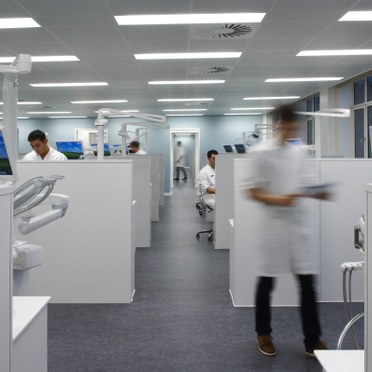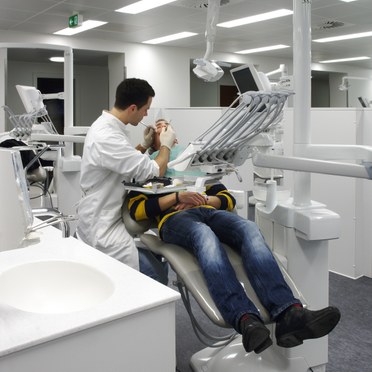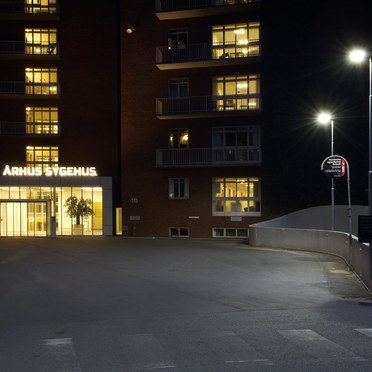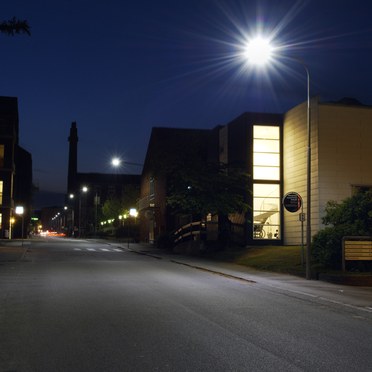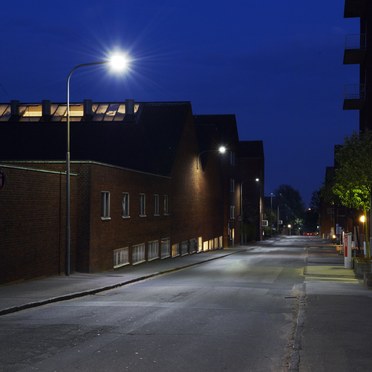School of Dentistry, Aarhus, Denmark
- Lamp efficacy
Lamp efficacy
Ensuring the lamp efficiently converts electricity into light (lm/W).
- Ballast classification
Ballast classification
Controlling the electricity supply to the lamp (Energy Efficiency Index).
- Luminaire distribution
Luminaire distribution
Controlling light emission using optics which bend and shape the light to the correct location.
- System efficacy
System efficacy
Combining optical and thermal control within the luminaire (luminaire lm/W).
- Presence/absence detection
Presence/absence detection
Presence: Lights automatically turn on/off with movement. Absence: Lights automatically turn off and must be manually switched on.
- Daylight detection
Daylight detection
Artificial lighting which responds to the natural light conditions.
- Constant illuminance
Constant illuminance
A function designed to produce correct light levels for the duration of the maintenance period.
- Task-scene setting
Task-scene setting
Allowing the user to set scenes and adapt the lighting to different tasks.
- Timed off
Timed off
Automatic cut-off can be installed to turn all lights off during unoccupied hours.
- Task lighting
Task lighting
Lighting task areas with the correct amount of light.
- Zoning of lighting
Zoning of lighting
Lighting is zoned according to area use.
- Maintenance schedule
Maintenance schedule
Maintenance must be performed in response to product age, performance and environment.
- Waste light
Waste light
Eliminating waste light which does not hit the intended target.
- Reflectance
Reflectance
Taking advantage of light which is reflected from the surface within the space.
- Visible smart metering
Visible smart metering
Results of actions can be quickly seen as increased or decreased energy use to encourage responsible energy consumption.
Dentist clinic lighting sets new standards
A technically intriguing refurbishment scheme has just been just completed by Thorn Denmark for the School of Dentistry in Aarhus.
It is the forerunner of many similar schemes now being planned by the University of Aarhus for its teaching clinics, where the introduction of special fluorescent luminaires is bringing about a new era of quality.
In conjunction with the School's consultant ALECTIA, an experimental installation using recessed fluorescent luminaires with special micro-prismatic panels was installed at a clinic. After a successful trial period, the scheme associates drew up a specification which Thorn successfully met.
The custom made luminaires are designed to provide a high quality of light in terms of colour, an Ra of over 90 enables dentists to select the right colour plastic for fillings, uniformity and freedom of glare. They replace a 30 year old scheme with yellow, glaring diffusers.
The average illumination level has risen from 700 to 1,000 lux - meeting the exacting requirements of Danish Standard DS 705:2002 - Artificial lighting in dental consulting rooms. Fitted with twin 54W T16 tubes, the new design requires half the number of luminaires needed previously, so permitting major savings in energy and capital costs. Each luminaire has intelligent DALI control to reduce operating hours.
The lights also feature extreme maintenance flexibility, with a smooth, sealed, surface for easy cleaning and the ability to quickly change lamps.
Five hundred luminaires have been fitted in four teaching hospitals and orders have been placed for a further six renovation projects next year. There’s a new look to the exterior too, and it’s all down to the use of Dyana LED road lanterns.
Architect for the Aarhus clinic was Erik Moller.

